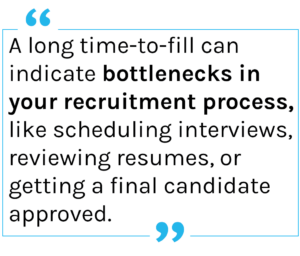Recruiting top talent for colleges and universities has never been more competitive.

To stand out in a crowded field and secure the best candidates, HigherEd HR teams need to adopt a data-driven approach to hiring. By tracking and analyzing the right metrics, HR professionals can measure the effectiveness of their recruitment efforts and make informed decisions to continuously improve their processes.
Read on to learn about the essential metrics that HR teams in higher education should focus on to better understand and repeat their recruitment success this year.
1. Application Rate:
Application rate is a core HR metric that indicates how attractive your open roles are to job seekers. A low application rate could suggest that your job descriptions aren’t resonating with candidates, while a high rate might point to a strong employer brand and effective outreach strategies.
2. Hiring Source:
Tracking hiring sources helps you identify which channels are most effective at bringing in qualified candidates. Whether it’s through job boards, social media, employee referrals, internal postings, or career fairs, understanding the sources that yield the best hires allows you to allocate resources to the most productive channels.
 3. Time-to-Fill:
3. Time-to-Fill:
Time-to-fill measures the average time it takes to fill a position from the moment it is approved for posting to the candidate’s acceptance of the offer—taking the whole hiring process into account. A long time-to-fill can indicate bottlenecks in your recruitment process, like scheduling interviews, reviewing resumes, or getting a final candidate approved. Some tools (like PeopleAdmin’s Insights) allow your team to look at time-to-fill across different departments or types of roles, to see if some teams are more efficient than others.
4. Offer Acceptance Rate:
This metric reveals the percentage of job offers that candidates accept. A low offer acceptance rate could signal that candidates are opting for competing offers, that the hiring process is taking too long, or that there’s a disconnect between the expectations set during the recruitment process and the actual job offering.
5. Diversity Metrics:
Diversity and inclusion are vital aspects of recruitment in higher education. Track metrics related to diversity, such as the percentage of candidates from underrepresented groups who applied, were interviewed, and were hired. Monitoring these metrics can help you pinpoint where you might need to focus your efforts—for instance, on attracting more diverse candidates or ensuring that your interview process is unbiased.
6. Candidate Experience:
Feedback from candidates about their experience throughout the recruitment process is invaluable. Survey candidates after each stage to gather insights on communication, responsiveness, and overall satisfaction. Improving candidate experience can positively impact your institution’s reputation and attract more qualified applicants.
7. Retention Rate:
While not a traditional recruitment metric, retention rate is a reflection of the quality of candidates you’re bringing on board. A high retention rate indicates that you’re not only hiring the right people but also providing an environment where they can thrive.
Final Thoughts
Data-driven recruitment is key to staying competitive in the higher education landscape. By monitoring these essential metrics, HigherEd HR teams can gain insights into their recruitment processes, identify areas for improvement, and make informed decisions that lead to better candidate matches.
Remember, these metrics work together; analyzing them collectively provides a comprehensive view of your recruitment success, enabling you to attract, hire, and retain the best talent for your institution. Leveraging tools like PeopleAdmin’s Insights can help you get the actionable insights you need for a data-driven strategy.